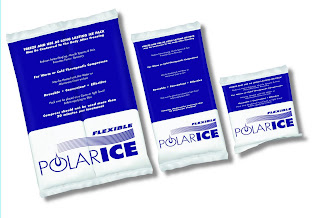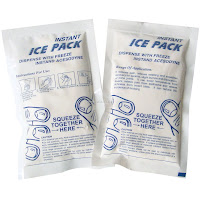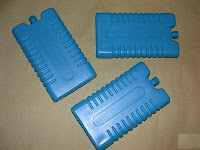This post is inspired by something I encounter regularly in my Los Angeles sports chiropractic office: Getting the right ice-bag for the job. Ice is ice, right? It all decreases or prevents inflammation, yes? No!
I’m writing this to explain it clearly–you gotta get the ice right.
 |
| $2 Ice Bag |
Many doctors (god bless ’em) recommend using a frozen bag of peas… Look at the photo on the right. Look how stupid that man looks with frozen broccoli on his knee. Looks like he’s in a hotel. Looks like he’ll be throwing away that bag of broccoli. Looks like he wasted food and two dollars. Disposable culture gone wrong.
Doesn’t every hotel have an ice machine? Duh! Fill a plastic bag with ice–it works like a charm. Plain and simple: frozen vegetables are not good ice packs. They do not retain the cold long enough, and once defrosted, you’ve got to eat or toss. Nobody has broken an inflammation with a bag of frozen vegetables.
| Home-Made Ice Bag works fine |
In fact, I like a home-made ice bag just fine. They do the trick as it needs to be done. The only knock I have against them is that they are a pain in the arse to make if you have to ice a lot, and so many people neglect their icing as a result. So, as a matter of convenience, I don’t think these are the way to go.
As far as I’m concerned, a pre-made ice-pack is best addition to your ice-bag arsenal. The gel material inside these babies freezes into ice crystals, yet it still retains it’s gel-like properties, allowing the cold-pack to contour to your body–invaluable when talking about icing a knee or shoulder with their sharp curves. Keep the bag in the freezer when not using it, and it will always handy when needed. I have several ice-packs of different sizes in my freezer, some have been with me for more than ten years. No kidding.
 |
| First two sizes ideal; last fairly useless |
In those instances where you need to ice several times a day, nothing is more convenient than having a freezer full of pre-made ice packs. You can even nail the injured area with ice several times in the same hour really making mince-meat out of the inflammation. But be cautious: bags that are too small will not remain cold for very long, and therefore I don’t find them very useful.
 |
| Crappy Short-Acting Pre-Mades |
Another no-no, as far as I’m concerned is using the crappy little packs they hand out at hospitals. Sorry, they may be inexpensive for the hospital, but they’re darn-near worthless otherwise. We were sent home with a few after the birth of each of my daughters. I was actually offended. What the heck are these going to do? I wondered. We tried them. They sucked. End of story.
 |
| For Ice Coolers |
Same with those packs for ice coolers or lunchboxes. They’re usually too small and/or too hard. Yeah, try icing a knee with one of those. Your inflammation won’t go away, and you will stop icing. I see these scenarios all the time.
Listen, for the inflammation of a joint or muscle, nothing beats ice. It’s the guaranteed way to decrease the pain and inflammation associated with musculoskeletal injuries. If you are active like me and many of my clients, you need pre-made ice bags in the freezer. You’ll tweak something here or there, or have a full-on injury. Icing immediately (or at least within the first 24 hours) saves many a chronic condition.
 |
| Use a barrier like a paper towel |
Also, don’t forget: Never put ice directly on your skin. Use a thin material as a barrier–I like paper towels, but tee-shirts, thin jeans, and so forth, are okay. Terry towels are too thick, so avoid using them.
Drop the frozen bag of peas nonsense, and grab a good pre-made ice pack from your chiropractor, physical therapist or online. I wouldn’t get anything smaller than a 6″ x 12″ (for shoulders, knees, ankles, and so on) and I’d have at least three of those, and I would grab at least two 12″ x 12″ bags as well for larger areas (neck/upper back, low back, buttocks). I use Polar Ice packs (see photo above), but there are many other decent ones on the market.
















